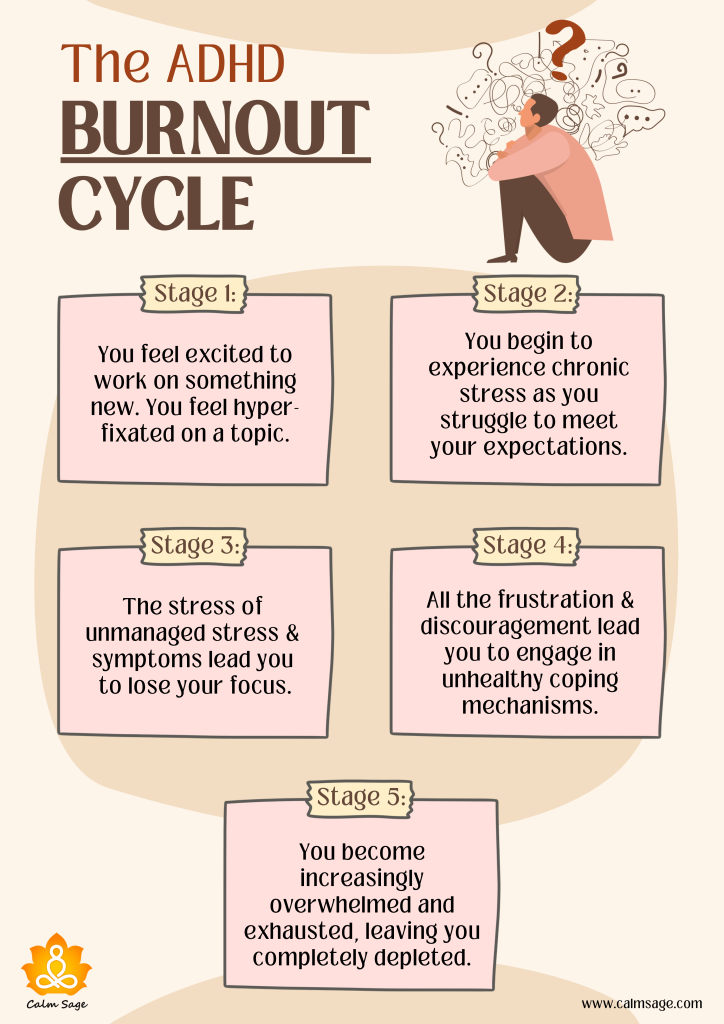ADHD Burnout? A Guide to Understanding and Recovering From ADHD Burnout
People with ADHD can experience symptoms of burnout from the constant effort to manage their symptoms. ADHD burnout is a state of mental, emotional, and physical exhaustion wherein you feel extremely fatigued, feel constantly overwhelmed, and find it difficult to focus. If you can relate to the experience, then reading this article will help you find the right help.

Lately, I feel like I’m running on fumes, coffee, and sheer willpower. And this is despite getting enough sleep! All my efforts go into staying focused and organized (even though it doesn’t feel that way), leaving me feeling emotionally drained and physically exhausted. Now, I can imagine this feeling tenfold if you have ADHD.
What I feel might be nothing compared to what you feel when you’re diagnosed with ADHD. If all this routine feels familiar to you, then it could be a sign of ADHD burnout, a state of exhaustion linked to managing ADHD symptoms in a world that doesn’t cater to them.
Unlike regular burnout that is caused by chronic work stress, ADHD burnout stems from the constant inner struggles of living with a neurological disorder. Imagine constantly fencing with inattention, disorganization, and impulsivity – all at the same time, some days! This ongoing effort can take a toll on your mental and emotional reserves, leaving you depleted.
If you’ve been struggling with ADHD burnout and its symptoms, then keep scrolling to understand where it comes from and how to recover from ADHD burnout.
ADHD Burnout: What Is It?
While it’s not a formal diagnosis, ADHD burnout is a common, if underdiagnosed, experience among people with ADHD. It describes a state of complete exhaustion – physical, mental, and emotional – brought on by the chronic stress and burden of managing ADHD symptoms.
Here’s an instance to help you understand it better;
A person with ADHD often expends more energy than neurotypical people to complete the same tasks. This is because, at the core, ADHD symptoms (inattention, hyperactivity, and impulsivity) make it harder for one to stay focused, plan well, and regulate emotions. This constant effort and exertion can eventually lead to a depletion of resources, hence burnout.
The ADHD Burnout Cycle
ADHD burnout doesn’t happen overnight; it’s a vicious cycle fueled by constant stress, frustration, and a sense of inadequacy. Here’s how the ADHD burnout cycle works;
Stage 1: You feel excited to work on something new. You feel hyper-fixated on a topic. Soon, the symptoms begin to show, and you struggle with inattention, hyperactivity, or impulsivity. You feel distracted, can’t manage time, and lose focus.
Stage 2: Now you have unmanaged ADHD symptoms. You begin to experience chronic stress as you struggle to meet your expectations. This constant burden and stress take a toll on your mental and emotional well-being, leaving you overwhelmed to complete what you started.
Stage 3: The stress of unmanaged stress and symptoms lead you to lose your focus, causing negative self-talk, feelings of inadequacy, and a subsequent decrease in your motivation levels.
Stage 4: Now, all the frustration and discouragement leads you to engage in unhealthy coping mechanisms such as procrastination, avoidance, or emotional eating/drinking. These unhealthy behaviors might give you temporary relief, but in the long run, they worsen underlying issues.
Stage 5: As this negative cycle continues, you become increasingly overwhelmed and exhausted. You can’t focus on anything, isolate yourself from your loved ones, and face physical health issues, too. Ultimately, it leaves you completely depleted, prompting you to give up on the task.

What Causes ADHD Burnout?
More often than not, unmanaged symptoms of ADHD are what causes ADHD burnout, but other factors also play a role. Some common contributing factors of ADHD burnout can include;
1. Unmanaged ADHD Symptoms
The core symptoms of ADHD – inattention, hyperactivity, and impulsivity – are at the base of ADHD burnout. Without effectively managing these symptoms, you can get caught up in the cycle of chronic stress, eventually causing burnout to take over.
2. Negative Social Reception
Many people with ADHD struggle with feelings of shame and inadequacy because of social pressure and negative stereotypes. This kind of reception from society can worsen feelings of frustration and can make you not reach out for help.
3. Demanding Jobs
If you work in a job that lacks structure, flexibility, and routine, then it can also become a challenge for you to manage your ADHD symptoms well. Workplaces with rigid guidelines and rules can become overwhelming, contributing to ADHD burnout.
4. Perfectionism
If you have ADHD, then you tend to strive to be perfect in every aspect of your life, which can be a double-edged sword. While it can encourage achievement, it can also cause frustration and disappointment when your goals remain unmet, contributing to ADHD burnout.
5. Major Life Transitions
Any transition or change you’re going through in your life can also be stressful enough to trigger ADHD burnout. Transitions in life can be stressful enough, but for people with ADHD, they can be especially overwhelming and can increase the risk of burnout.
6. ADHD Masking
Another common experience of ADHD is masking. In this, you try to hide your symptoms from others by trying to look and act neurotypical. This ADHD masking can cause you distress, as the toll of hiding your symptoms can be high. This pressure can cause burnout too.
7. Poor Management
Executive dysfunction is another symptom of ADHD, where it becomes hard for you to manage time and prioritize tasks. This poor management can also cause significant cognitive distress, causing you to feel ADHD burnout.
8. Lack of Routine
Just like a lack of structure in the workplace can be triggering, a lack of routine in your daily life can be triggering too. If you live with ADHD, then you need a schedule, a structure, to go around. Not having that can make you more prone to burnout.
ADHD Burnout Recovery: Tips to Help!
ADHD burnout doesn’t have to be a permanent state. With some effective and practical strategies, you can recover from ADHD burnout and live your life with a renewed sense of energy. Here are some tips to help you;
1. Seek Professional Support
A therapist or counselor who specializes in ADHD treatment can help you find valuable support and guidance to recover and prevent burnout. They can help develop healthy coping skills, manage stress, and address underlying mental health conditions like anxiety, stress, and depression.
2. Take Care of Yourself
Make self-care a non-negotiable part of your routine. This can include getting quality sleep, eating healthily, and getting regular exercise. Physical activity can help reduce stress and improve well-being. You can also engage in activities that make you feel good, such as meditation, yoga, or spending time in nature.
3. Establish a Routine
Create a routine or a structure you can follow. Having a routine can help you manage ADHD symptoms. You can use planners, set realistic goals, and break down your tasks into manageable chunks. Use apps and digital tools to your advantage.
4. Learn to Say “NO”
Don’t be scared to set boundaries and say “NO” when you feel overwhelmed. Saying “NO” protects you from losing your energy and allows you to focus on what matters. Communicate your needs and limits to your loved ones, coworkers, and acquaintances to avoid feelings of resentment and guilt.
5. Become More Mindful
Being mindful can help you manage stress and improve your focus. Mindfulness techniques such as deep breathing and meditation can be good tools to begin with. These exercises can help you become more aware of your thoughts and feelings without judgment, lowering your chances of being impulsive.
6. Connect With Others
Find people or groups to connect with who understand your ADHD. Support groups and online communities can be a good place to start. These groups can offer you a safe space to share experiences, learn from each other, and feel less alone in a world where ADHD feels unique.
Wrap Up…
ADHD burnout is a real challenge, but it’s not insurmountable. Knowing the ADHD burnout cycle, identifying its triggers, and incorporating effective management strategies, you can learn to recover from and prevent ADHD burnout in the future. You’re not alone. Various resources and support systems are there to help you manage your ADHD and live a fulfilling life.
I hope this article helped you understand what ADHD burnout is, its causes, and how to recover from it. Let us know your thoughts in the comments below.
Take Care!




















